I thought it was Purple, but they say it's Mauve or sometimes Pink. Polygala myrtifolia is sometimes called by the common names "Milkwort" or "Sweet Pea Bush". This time of year in Sydney, there are some nice examples of this plant to see around. This is a fast growing , medium sized shrub, growing up to 2 metres, and it puts on a glorious display of Mauve flowers. It is best planted in full sun and suited for temperate or warm climates. There are some dwarf hybrids available which are suitable for either pots or garden planting, and some prefer these as the regular variety is considered a weed in some places.
These photos were taken in Sydney's Nothern Suburbs. 

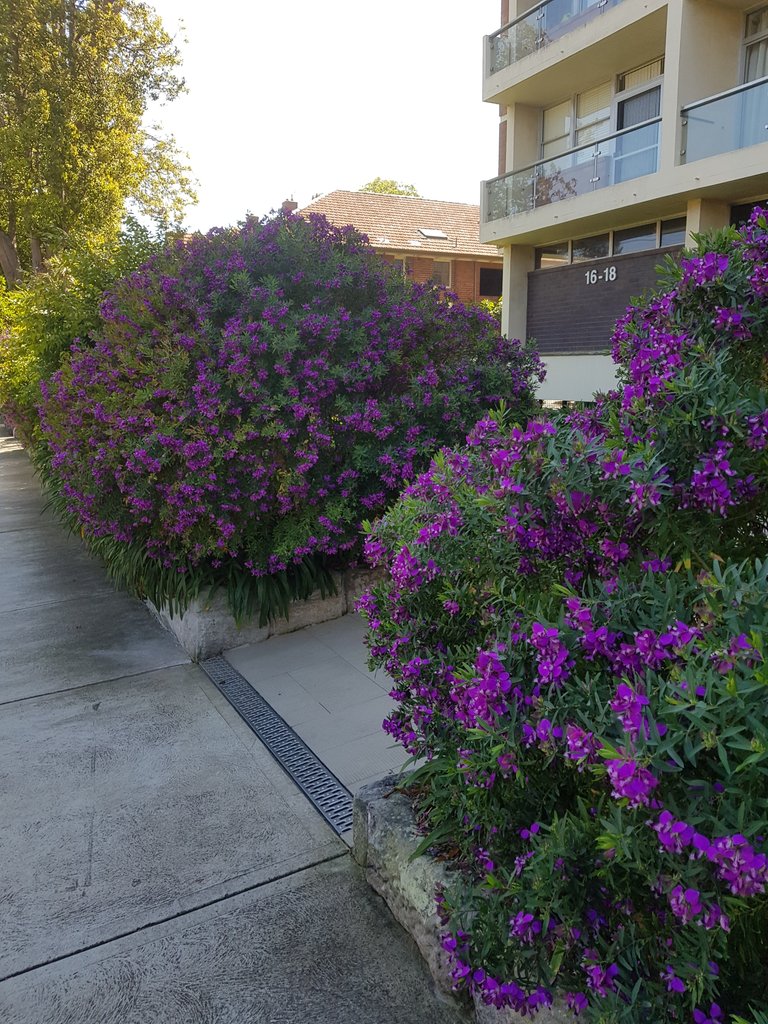
Shared on twitter promoting good quality content on #Steemit. Stephen
#Promo-Steem #steemtalent #JoinSteemit #Steemit
Polygala - colour me Mauve. #STEEM #steemtalent #JoinSteemit #Steemit @Steemit
#GardenersWorld #Gardening #Garden #Plants #Australia #Photographer #Photography #Blog #Blogger
Polygala of the milkwort family is a genus featuring over 500 species of plants (annuals, herbaceous perennials, subshrubs and shrubs) which are widely distributed in warm to temperate regions throughout the world. Plants are generally noted for having alternate lanceolate leaves and pea-like often showy flowers in terminal clusters/racemes.
Polygala x dalmaisiana, commonly called sweet pea bush or milkwort, is a loose, leggy, fast-growing, rounded to spreading, bushy evergreen shrub which typically grows to 3-5’ tall and as wide. It is reportedly a hybrid between two South African species (P. opposistifolia and P. myrtifolia). Stems are clad with ovate dull green leaves (1” long). Terminal racemes of rose-magenta pea-like flowers with two winged petals surrounding a white purple crest bloom summer to frost, but bloom extends to almost year round in mild frost-free climates with minimum temperatures of 40 degrees F. Flowers resemble those of sweet pea.
Genus name comes from the Greek words polys meaning much and gala meaning milk in reference to a belief dating back to the medieval era that ingestion of plant leaves by certain nursing mammals resulted in increased milk production.
http://www.missouribotanicalgarden.org/PlantFinder/PlantFinderDetails.aspx?taxonid=362665&isprofile=0&
Polygala myrtifolia varies in form as it changes to adapt to the different areas it grows in, from the harshness of the coast to the drier inland climates. An evergreen shrub, the most common forms reach about 0.6 to 1.8 m in height with a few upright-growing stems and slender branches densely covered with leaves that resemble myrtle. The oval-shaped leaves are usually 25-50 mm long and up to 13 mm wide. The leaves are light green, dark green or slightly grey. Some forms of P. myrtifolia have thin, needle-like leaves. It can also grow into a small tree reaching almost 4 m high.
The buds are green, flat, marked with dark veins and oval to half-moon-shaped. The lower buds open first. The flowers are carried in small clusters at the ends of short branches and look a bit like legume (pea or bean) flowers, but are actually quite different. Close inspection will reveal that although they have two wings and a keel, they lack the banner (also called standard) petal. All polygalas also have a showy, and very distinctive brush-like tuft on the keel. The showy petals, beautifully marked with darker veins, are usually in shades of mauve or purple, but can also be pink scarlet, or white. Polygala myrtifolia has blooms throughout the year with a peak in spring ( August to October) when the plants flower profusely. The fruit is a small, winged capsule.
http://pza.sanbi.org/polygala-myrtifolia
@ctrl-alt-nwo,
Wow it's really stunning! The flower looks like an Orchid but with that bush type it's perfect for gardening! Great photography and description! I didn't see this plant in my country! if it's here, it might get a lot of attention from people who loves gardening!
Cheers~
Sweet Pea Bush
To our many customers who have enjoyed the flowering delights of the Sweet Pea Bush (Polygala) and who might well be wondering how to look after this beautiful perennial over winter, read on.
Well as with most things there is no right answer in terms of protection, much depends on the severity of the winter. If your Sweet Pea bush is potted try to move it to the most sheltered part of the garden ideally up against the house, this should offer reasonable protection from the worst of the winter winds, frosts and snow.
If your Sweet Pea bush is planted out, hopefully you remembered to provide a well-drained environment, this above all else will help to keep the Sweet Pea in good shape through the colder months.
The last three winters have been quite mild and haven’t really troubled the Sweet Pea Bush especially here in the South of the UK, but if we do see a very cold winter, wrapping the Sweet Pea bush in hessian or fleece would certainly be beneficial.
Come Spring give the Sweet Pea bush a light prune to keep its rounded shaped and prevent a woody habit.
https://www.athelasplants.co.uk/sweet-pea-bush/
Silly Sausage Award !! Well done , nice selection of Pics.
These are very impressive huge balls of purple flowers!
Lots of fun in these deep colour petals!
I will have to look around here if we have this plant in Thailand.
An attractive evergreen shrub that grows up to 2 meters, the September bush is able to adapt to most garden situations. It is fast growing, making it especially useful for new gardens. Polygala myrtifolia in the wild varies in form according to its habitat and distribution. In some areas it is a tough, loosely branched plant with relatively small, narrow leaves, while in others it is denser with larger, softer leaves. It flowers best in full sun, really dry conditions, poor soil and the least possible care - see natural habitat in photograph 6 above. Good in wild gardens, very dry gardens and exclusion zones.
The September bush will grow in most soil types. Polygala myrtifolia needs very little watering once established. It can be lightly pruned to shape, which encourages a more bushy habit and will keep it within bounds. Left to itself, growth is a bit more lax. Fewer flowers are produced in shady spots. Useful in areas that change from full sun in summer to semi- or full shade in winter.
Source: https://kumbulanursery.co.za/plants/polygala-myrtifolia
Very good-looking flowers there @ctrl-alt-nwo and they do resemble like a flowering pea pod. The color is beautiful with its purple shade.
This South African shrub to 2 m high is widely naturalised across southern Australia and has become invasive in coastal areas. These shrubs are most readily recognised by their mauve-purple, pea-shaped flowers produced throughout most of the year, predominantly during spring. Flowers develop two-celled flattened seed capsules that ripen from green to papery brown. Whilst the plainer form with greenish lower petals is frequently observed as weedy, the showier cultivar 'Grandiflora' with larger flowers and purple lower petals has also been observed readily spreading from plantings.
http://www.growmeinstead.com.au/plant/polygala.aspx
Congratulations @ctrl-alt-nwo!
Your post was mentioned in the Steemit Hit Parade in the following category:
Great, thankyou !
Polygala myrtifolia, the myrtle-leaf milkwort, is an evergreen 2-4m tall South African shrub or small tree found along the southern and south-eastern coasts, from near Clanwilliam in the Western Cape to KwaZulu-Natal. It is a fast-growing pioneer plant, a typical fynbos component, and may be found on dunes, rocky places, along forest margins, beside streams, and in open grassland. It belongs to the milkwort family of Polygalaceae.
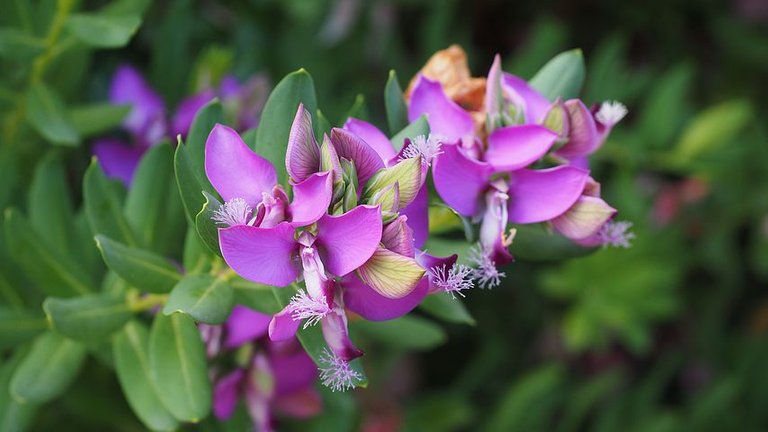
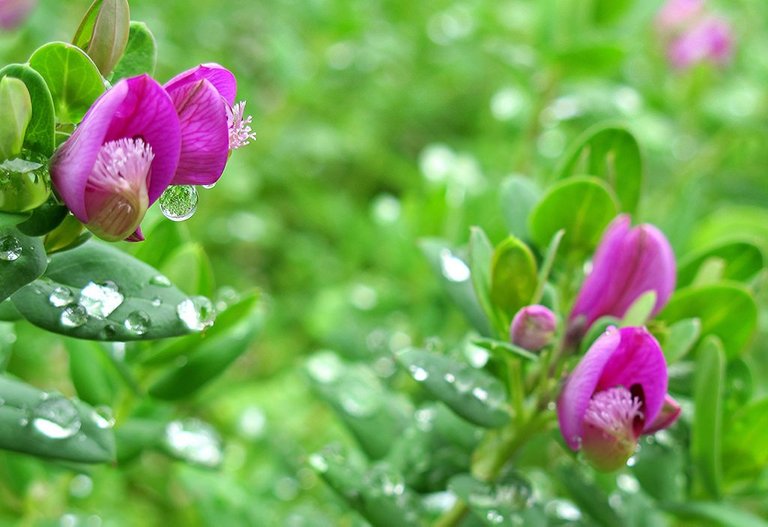
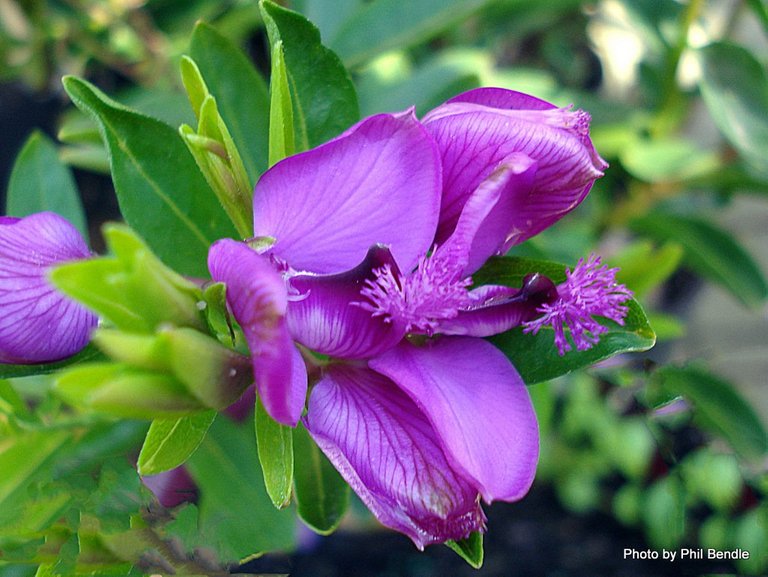
Source
The thin, oval, mucronate leaves, 25–50 mm long and up to 13 mm wide, are arranged alternately and have entire margins - some forms of P. myrtifolia have thin, needle-like leaves. The attractive mauve sweetpea-like flowers, which close at night, may also be pink, crimson or white, and have a characteristic brush-like tuft protruding from the keel. For pollination an intricate piston mechanism is used. The fruit is an oval, brown, dehiscent capsule which is narrowly winged. The species is often cultivated in South African gardens.
Source
The genus of Polygala comprises some 360 species with a wide distribution in the tropics and temperate zones. 'Polygala' is interpreted as 'much milk' since the plant was thought to stimulate milk production in European cows - 'myrtifolia' translates as 'myrtle-shaped leaves'.
Source
This species has become naturalised in some of the coastal areas of Australia, Norfolk Island, New Zealand and California.
Source
Sweet pea shrub
Other common names
sweet pea shrub
Family
Polygalaceae
Genus
Polygala can be annuals, evergreen perennials or shrubs, with simple leaves and racemes of somewhat pea-shaped flowers.
Details
P. x dalmaisiana is a bushy evergreen shrub to 1.5m, with dark green, ovate leaves and terminal racemes of pea-like, reddish-purple flowers 2.5cm long, in summer and autumn.
https://www.rhs.org.uk/Plants/56000/Polygala-x-dalmaisiana/Details
Very beautiful plants. The first photo is amazing. Your photos are better and better with every time.
Polygala is a large genus of flowering plants belonging to the family Polygalaceae. They are commonly known as milkworts or snakeroots. The genus is distributed widely throughout much of the world[1] in temperate zones and the tropics.[2] The genus name Polygala comes from the ancient Greek "much milk", as the plant was thought to increase milk yields in cattle.
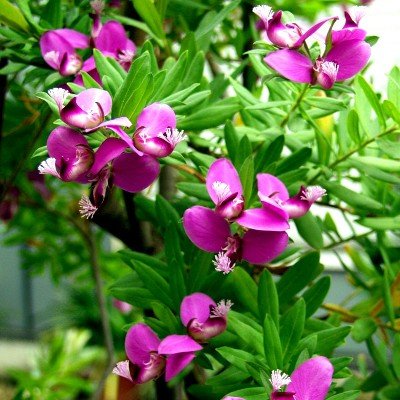
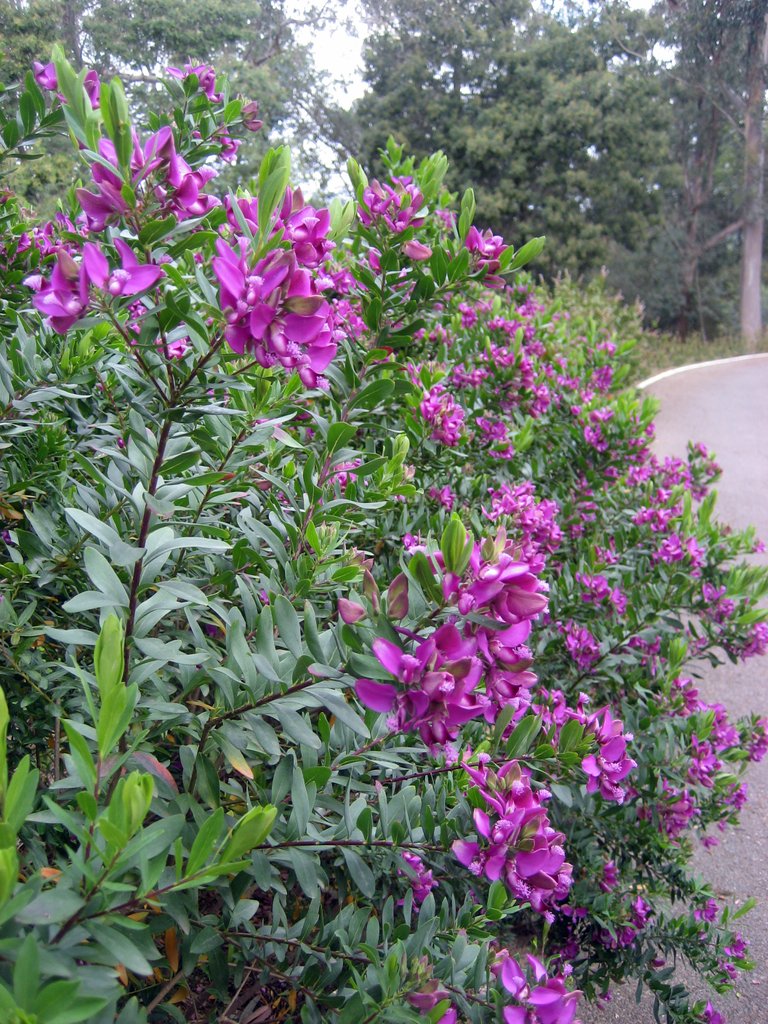
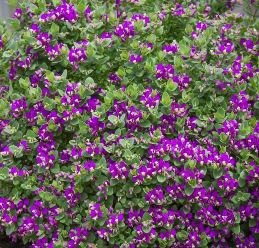
,_Set%C3%BAbal,_Portugal,_2012-05-08,_DD_02.jpg)
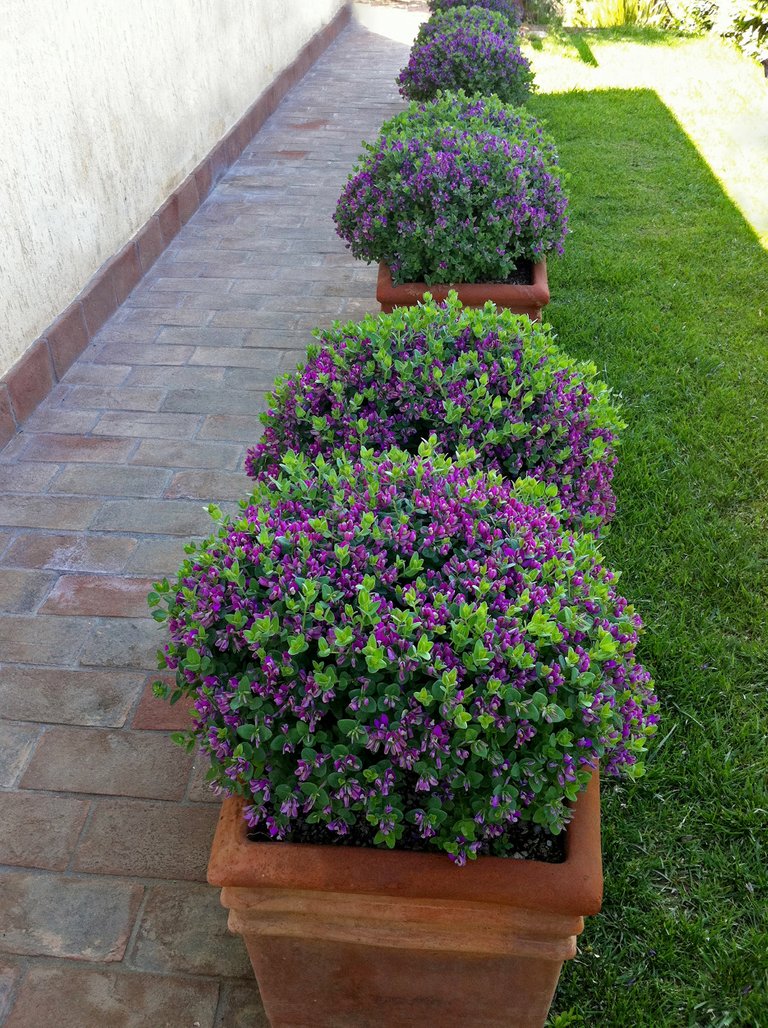
Polygala includes annual and perennial plants, shrubs, vines, and trees.[1] The roots often have a scent reminiscent of wintergreen.[2] The leaf blades are generally undivided and smooth-edged, and are alternately arranged in most species. The inflorescence is a raceme or spikelike array of several flowers; the occasional species bears solitary flowers.
The flower is bilateral in shape, with two large petal-like sepals on the sides, often called the "wings",[2] and three smaller sepals behind. There are three petals in shades of reddish purple, yellow or white, which are joined at the bases. The lower of the three is the keel petal, which is "boat-shaped, cucullate [hood-like], or helmet-shaped.
The lower of the three is the keel petal, which is "boat-shaped, cucullate [hood-like], or helmet-shaped".[1] The keel petal may have a beak or a fringe on the tip.[2] Stamens and style are within the curve of the keel petal. The fruit is a capsule, sometimes winged. It contains 2 seeds[1] which are usually black, hairy and tipped with a large white aril.[2] One polygala is the Fringed Polygala, found in coniferous forests.
(Source)https://en.m.wikipedia.org/wiki/Polygala.
Very interesting petals of this plant. I wonder what function does the white bristle on the edge of the central petal perform? This is an open pistil and stamens?
You surprise every time with new colors for me! Thank you!
Yes they are the reproductive part of the flower. They are designed to rub on the bees backs, legs etc when they go to the flower. That way, the bees can polinate other flowers as they travel between plants. Nature's smart design !
You shared wonderful photography among us and your last photo was really nice. Your last photo impressed me. I saw a lot of photography, but your photography has been so beautiful and I would like to thank you for sharing the flowers I really love it
They looks super elegant nice to have around for sure thanks for sharing about this :)
Polygala myrtifolia "Riviersonderend" is a miniature form of the well-known Polygala myrtifolia. Hardy, evergreen, drought-resistant shrublet growing to only 1m tall. It has bright-green, broadly-lanceolate leaves.
The magenta flowers are borne in lax terminal heads throughout summer and autumn, and attract Carpenter Bees, butterflies and other tiny, pollinating insects to the garden. The seeds are relished by Laughing Doves.
This handsome compact form is an ideal alternative for the garden that is too small for the large tree-like form of the Polygala myrtifolia. A useful garden and container plant.
Prune regularly. Enjoys well-composted soil in a sunny or lightly shaded position.
Size: up to 100cm
Wildlife:
Uses:
Distribution:
Coastal areas - Western Cape
source
@ctrl-alt-nwo, Third picture is truly speaking the beauty of this plant and it's flowers. And genuinely speaking these kind of plants and those flowers which spreading the colourful essence in Environment will going to make our outer experience so pure and organic.
And whenever we see the Plantation in row specially plantation in row but different and diversified plants gives the breathtaking essence, and it also encourage others to do Home Based Plantation.
Wishing you an great day and stay blessed. 🙂
so many flowers I haven´t eben seen in Australia. Good inspiration to plant some new things in the Garden of my friends! They look great
wow...that was a cool flower crowded with beatiful flowers i love it!😍😍
Yours looks like a Lasiandra.
can i look what Lasiandra is,you have any of it sir?
lasiandra is same plant as Tibouchina. I did a few posts a while ago on it. You can look back in my blog and see.
oh..i never saw your post just online back to steemit because my phone data storage are all used up..i'll check it right away..thank you sir.
I did not saw the flower you mean..but this flower of yours took my attention the leaves are the on my flowers..
I'm happy you like them :)
if we are talking about flowers hhmmm...i would surely love it,and i'm happy to see other flowers from other country..by the way,thanks for sharing those flowers around your country..
Myrtle-leaf milkwort (Polygala myrtifolia) has been widely cultivated as a garden ornamental, particularly in the temperate regions of Australia. The typical form of the species is generally no longer cultivated, but a modern cultivar (i.e. Polygala myrtifolia 'Grandiflora') is now widespread in cultivation. This cultivar was thought to be sterile, but it has recently been found to set some seed.
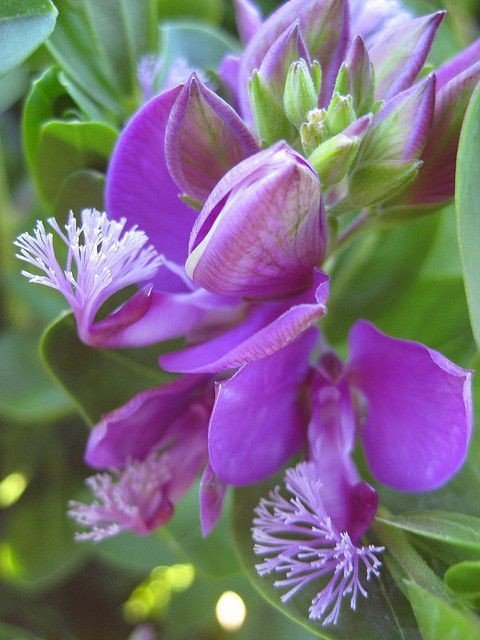
sources
source
Widely naturalised in the coastal districts of southern Australia (i.e. in the coastal districts of eastern New South Wales, Victoria, Tasmania, southern South Australia and south-western Western Australia). Less common in the sub-coastal and inland regions of Victoria, South Australia and south-western Western Australia. Also naturalised on Norfolk Island.
Naturalised overseas in New Zealand and south-western USA (i.e. California).
source
Description:
Little Polly™ features vibrant mauve blooms for most of the year with the main flush appearing in spring and summer.
Key Features:
Polygala Little Polly™ is a dwarf evergreen shrub with stunning grey-green foliage.
Cultural:
Polygala Little Polly™ prefers a postion in full sun, in well drained soil, and can be pruned if desired.
Plant Landscape:
Polygala Little Polly™ is heat and frost hardy and will look great in a variety of garden styles and sizes. It is perfect for garden borders, pots, and containers.
Max Height: 100 cm
Size: 1m x 1m
Position: Full Sun to Part Shade
source
Polygala myrtifolia is a common, widespread pioneer shrub with pretty mauve flowers on and off throughout the year with a peak in spring, hence the names Augustusbossie and September bush.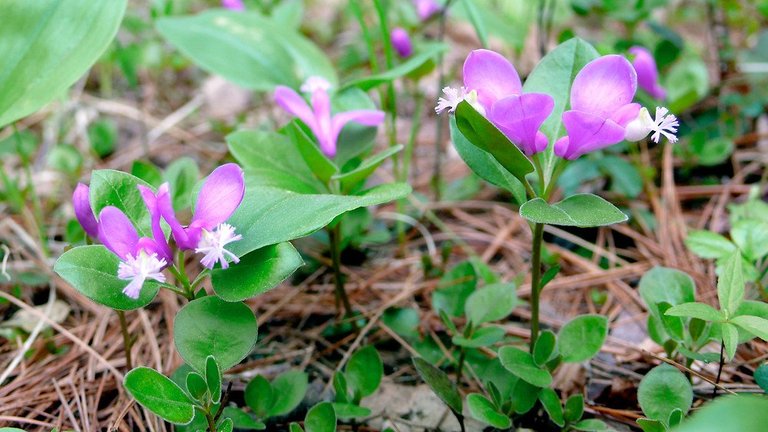
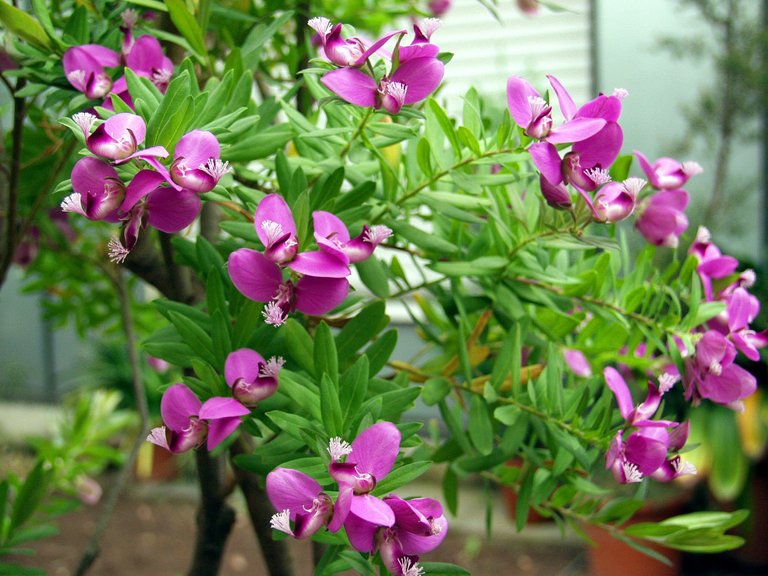_-_Botanischer_Garten_Bonn.jpg)
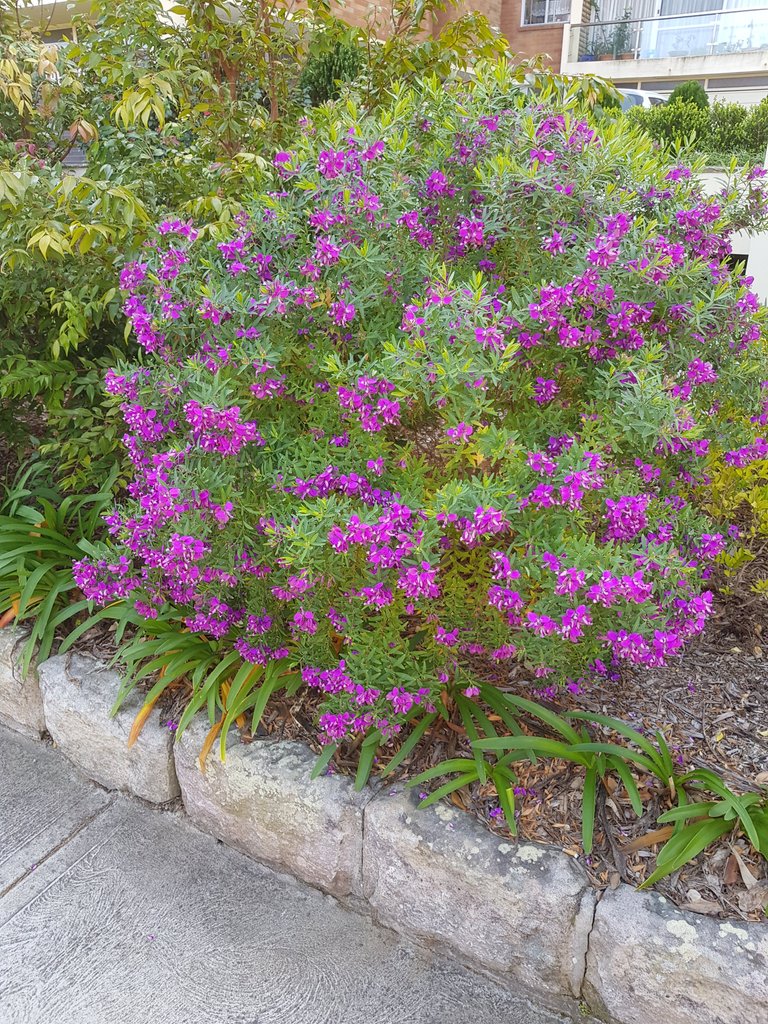

source of image
Polygala myrtifolia varies in form as it changes to adapt to the different areas it grows in, from the harshness of the coast to the drier inland climates. An evergreen shrub, the most common forms reach about 0.6 to 1.8 m in height with a few upright-growing stems and slender branches densely covered with leaves that resemble myrtle. The oval-shaped leaves are usually 25-50 mm long and up to 13 mm wide. The leaves are light green, dark green or slightly grey. Some forms of P. myrtifolia have thin, needle-like leaves. It can also grow into a small tree reaching almost 4 m high.
source of image
The buds are green, flat, marked with dark veins and oval to half-moon-shaped. The lower buds open first. The flowers are carried in small clusters at the ends of short branches and look a bit like legume (pea or bean) flowers, but are actually quite different. Close inspection will reveal that although they have two wings and a keel, they lack the banner (also called standard) petal. All polygalas also have a showy, and very distinctive brush-like tuft on the keel. The showy petals, beautifully marked with darker veins, are usually in shades of mauve or purple, but can also be pink scarlet, or white. Polygala myrtifolia has blooms throughout the year with a peak in spring ( August to October) when the plants flower profusely. The fruit is a small, winged capsule.
source of image
source of image
Polygala myrtifolia occurs naturally from the Bokkeveld Mountains near Clanwilliam in the Western Cape to Kwazulu-Natal. Along this wide distribution area changing from winter to summer rainfall, it is commonly found growing on dunes, rocky slopes, in forests, along streams, in scrub and open grassland.
source of article
Wow wonderful flowers garden. the look like to color mix. its really.
this is wonderful photography.thanks for the information and i like it.
@ctrl-alt-nwo
The bilaterally symmetrical flowers superficially resemble those of the Fabaceae, but the structures are not homologous. Of the 5 sepals, the 2 lateral ones are large and petaloid, usually as large as the petals; the petals are 3, the lower one forming a keel which encloses the stamens and style and usually has a fringe or appendage near the end.
The stamens are 6 (in P. paucifolia), 7, or 8. The seeds are pubescent and bear an aril (or aril-like structure), which apparently aids in dispersal by ants. Some species also produce reduced cleistogamous flowers, underground or above ground; except when explicitly stated, the key does not refer to these. The lowermost leaves are often reduced to scales.
Flowers numerous, ca. 3–7.5 mm long, the wings persistent; well-developed leaves several to many (or often none at anthesis in P. incarnata).
Leaves (at least the lower ones) whorled (or opposite, look for scars if necessary).
source
magoo-2 found a series of multi accounts of a same owner is following your articles to cheat your generous rewards.
magoo-2 found these accounts are suspicious & can be multi accounts of a single owner. Conclusion is based on last 30 days transactions:
@kilee
@ripon1
@googlefighter
@melianasagita
@ashasikder
@hichako
@sadikulaziz
magoo-2
Check our latest multi comment spam update report
Fringed Polygala, Gaywings, Flowering Wintergreen (Polygala paucifolia Willd.)
By Brandee Wenzel
Easily mistaken for an orchid, this bright little jewel is always a delight to stumble across. A member of the Polygalaceae or Milkwort Family, this and fellow species in the genus Polygala produce compounds reputed to increase milk production in nursing mammals. In fact, Polygala is derived from the Latin “poly” meaning “many, much” and “gala” meaning “milk”. Ethnobotanical references to Gaywings were recorded in James Herrick’s 1977 Iroquois Medical Botany, in which the majority of use was indicated for skin inflammations such as abscesses, boils, and sores.
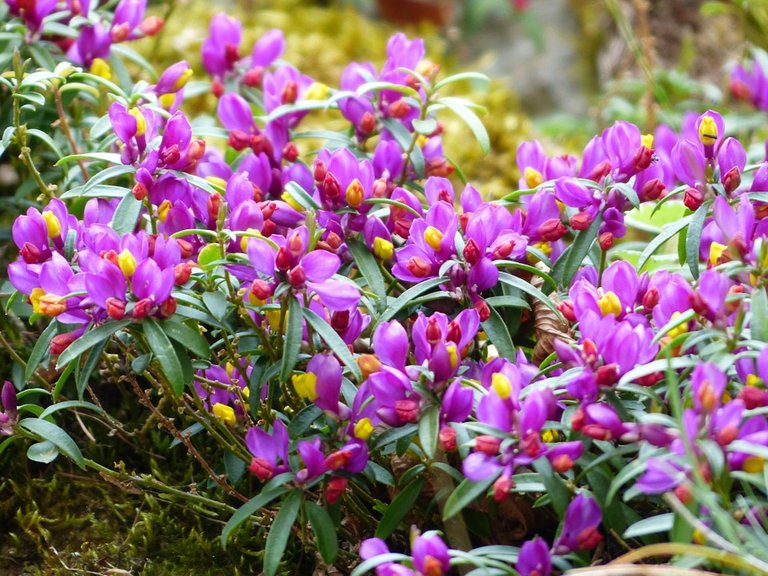
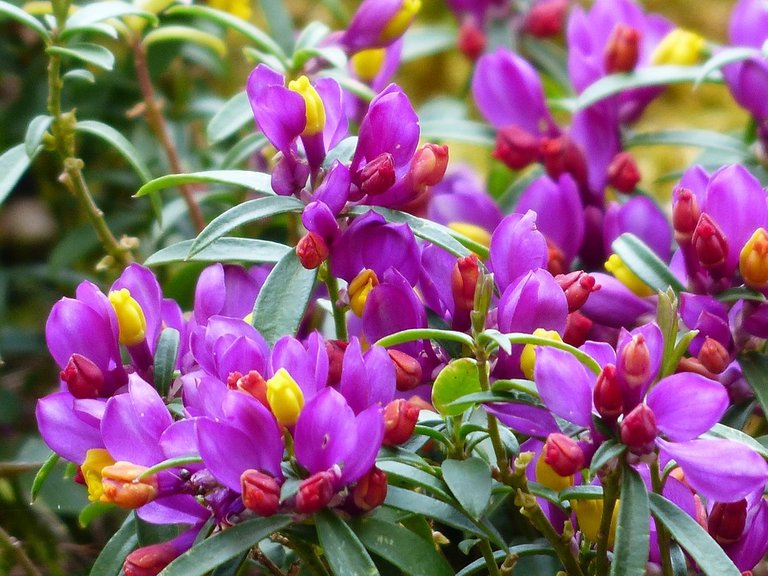

Fringed polygala emerges from creeping, partly underground stems, and is typically no taller than 15 cm (6 inches). Its upper leaves are oval and crowded at the top of the stem, which gives this plant its resemblance to wintergreen. The light pink to deep magenta flowers are made up of five sepals and three petals. The sepals consist of three small outer and two large, showy petal-like “wings”. Of the petals, two are united to form a tubular structure, with the third keeled or boat-shaped petal cresting in a delicate yellow or pink fringe or frill. The keel encloses the reproductive structures, and when a bug lands on the keel, these structures are exposed for pollination. Besides the showy flowers that are insect-pollinated, there are also inconspicuous flowers that are borne underground and which self-fertilize without opening.
Besides Minnesota, gaywings thrive in dry to moist conifer forests from the eastern half of Canada and northeastern United States down to the mountains of Tennessee and Georgia. Its bloom time is spring to early summer. There are over 60 different kinds of Polygala in the United States, with the greatest diversity in the Southeast. Those of us living in the northern United States are fortunate to have an abundance of this wildflower to brighten our woods in the spring.
https://www.fs.fed.us/wildflowers/plant-of-the-week/polygala_paucifolia.shtml
magoo-2 found a series of multi accounts of a same owner is following your articles to cheat your generous rewards.
magoo-2 found these accounts are suspicious & can be multi accounts of a single owner. Conclusion is based on last 30 days transactions:
@moniristi
@shishiristi
@aflatunnisa
@hafez
@shihabieee
@mrashik
magoo-2
Check our latest multi comment spam update report
Polygala myrtifolia is a hardy, large, evergreen shrub with glossy green leaves.
It bears abundant, mauve pea-like flowers almost all year round with a flush in late winter.
It makes a decorative small tree if pruned into a standard and makes a beautiful floriferous screening plant. It can also be pruned into a formal hedge.
Attracts Carpenter Bees to the garden.
The seeds are relished by laughing doves and other seed-eating birds.
Grows in sun or semi-shade but flowers best in full sun and makes an excellent container plant.
source
Facts
The September bush is a common, widespread, pioneer shrub that flowers on and off all year round, peaking in the spring.
The flowers resemble that of a pea-flower and close at night time.
This plant was believed to enhance milk production in livestock.
Where it grows
Occurs naturally in South Africa, from the Bokkeveld Mountains near Clanwilliam in the Western Cape to Kwazulu-Natal. Commonly found growing on dunes, rocky slopes, in forests, along streams, in scrub and open grassland.
Useful links
Plantz Africa
Queensland Government, Weeds of Australia
Glossary
Capsule: dry fruit that opens by valves, slits or pores to release seeds (dehiscent) and is composed of two or more united carpels (the basic unit of the female sexual organ).
Keel: lower petals resembling the bottom of a boat.
Obovate: two-dimensionally egg-shaped with widest part at the apex.
Raceme: a flowering structure where the individual flowers are clearly stalked, the newest and last to open being at the apex.
source
Description:
Polygala fruticosa "Petite" is a hardy, evergreen, shrublet that has shiny, grey-green, heart-shaped leaves that have red margins. The young leaves are a shiny, coppery pink.
The clusters of gorgeous, magenta, pea-shaped flowers appear from August to May and attract bees and other pollinating insects to the garden.
This beautiful plant is great in a mixed border, rockeries, Terraforce walls or containers. Used in traditional medicine.
Plant in compost-rich soil in full sun or semi-shade and water well when planting and until settled. Thereafter it will tolerate quite dry conditions.
Size: 0.4 to 1m
Wildlife:
Uses:
Distribution:
KwaZulu Natal, E. Cape, W. Cape
source
What Is A Sweet Pea Bush: Tips For Growing Sweet Pea Shrubs
Sweet pea shrubs are neat, rounded evergreens that bloom off and on all year long. They’re perfect for those spots where you get shade in the summer and full sun in winter. Sweet pea shrubs make wonderful additions to mixed perennial borders in warm climates, and they also look great in patio containers. These tidy evergreen plants bloom in shades of purple or mauve with flowers that are great for bouquets and arrangements. Find out how to grow a sweet pea bush in this article.
Unrelated to sweet pea garden flowers (Lathyrus odoratus), the sweet pea shrub (Polygalaspp.) gets its name from its similar-looking flowers. Sweet pea shrubs attract bees, butterflies and birds, making it an excellent choice for wildlife gardens. It grows 2 to 3 feet tall and thrives in sun or shade. Native to South Africa and sensitive to frost, it survives winters only in U.S. Department of Agriculture plant hardiness zones 9 and 10.
Care of Sweet Pea Bush The care of sweet pea bush is minimal. Sweet pea shrubs survive without a lot of supplemental irrigation, but they look best if you water them regularly. Remember that those grown in containers need water more often than those grown in the ground. Since they bloom year round, they appreciate a little general purpose fertilizer in both spring and fall. One of the things that make sweet pea bush care so easy is that it needs little or no pruning. If you need to control the size, you can give it a light trim any time of year. The stems on older shrubs may become woody. In that case, you can cut it to about 10 inches above the ground and let it regrow. Otherwise, just leave it to grow naturally. You might also want to try growing sweet pea shrubs as a small tree or standard. In that case, remove all but one stem arising from the ground and take off the side branches on the lower one-half to two-thirds of the trunk while the plant is young. You can propagate Polygala species from seeds, which fall to the ground and take root if you don’t deadhead the plants regularly. Hybrids are usually sterile. Propagate them from softwood cuttings taken in spring or fall.
https://www.gardeningknowhow.com/ornamental/shrubs/sweet-pea-shrubs/growing-sweet-pea-shrubs.htm
Sweet pea shrubBotanical Name
Polygala myrtifolia
Family
Polygalaceae (milkwort)
Where is it originally from?
South Africa
What does it look like?Evergreen legume-like shrub (<2 m tall) with young shoots that have short curly hairs, otherwise the plant is hairless. Smooth, woody, stems are much branched, and oval leaves (15-30 mm long) are arranged alternately on the stem. Three-petalled purple and green (on outside of side petals) sweet-pea like flowers (15-17 mm long) appear from January to December in short clusters at the end of stems, and are followed by flat, heart-shaped seed capsules (10 mm long) containing hairy, dark brown seeds (5 mm long).



Sweet pea shrubs are neat, rounded evergreens that bloom off and on all year long. They’re perfect for those spots where you get shade in the summer and full sun in winter. Sweet pea shrubs make wonderful additions to mixed perennial borders in warm climates, and they also look great in patio containers. These tidy evergreen plants bloom in shades of purple or mauve with flowers that are great for bouquets and arrangements. Find out how to grow a sweet pea bush in this article. What is a Sweet Pea Bush? Unrelated to sweet pea garden flowers (Lathyrus odoratus), the sweet pea shrub (Polygalaspp.) gets its name from its similar-looking flowers. Sweet pea shrubs attract bees, butterflies and birds, making it an excellent choice for wildlife gardens. It grows 2 to 3 feet tall and thrives in sun or shade. Native to South Africa and sensitive to frost, it survives winters only in U.S. Department of Agriculture plant hardiness zones 9 and 10.
Care of Sweet Pea Bush The care of sweet pea bush is minimal. Sweet pea shrubs survive without a lot of supplemental irrigation, but they look best if you water them regularly. Remember that those grown in containers need water more often than those grown in the ground. Since they bloom year round, they appreciate a little general purpose fertilizer in both spring and fall. One of the things that make sweet pea bush care so easy is that it needs little or no pruning. If you need to control the size, you can give it a light trim any time of year. The stems on older shrubs may become woody. In that case, you can cut it to about 10 inches above the ground and let it regrow. Otherwise, just leave it to grow naturally.
Read more at Gardening Know How: What Is A Sweet Pea Bush: Tips For Growing Sweet Pea Shrubs https://www.gardeningknowhow.com/ornamental/shrubs/sweet-pea-shrubs/growing-sweet-pea-shrubs.htm
Polygalas, also known as Milkworts or Snakeroots, are a large genus spread throughout the world as they are adaptable to a wide range of growing conditions. Flowers are normally mauve and the rounded green leaves are a contrast to the distinctive 'pea like' flowers which are borne in profusion on these compact sub-shrubs. Our selection, Polygala 'Little Bibi' is somewhat special in that it holds a neat 'topiary' form even without a lot of trimming. This is a great asset to the busy gardener.
Source
Polygala x Dalmaisiana is a superb choice for conservatories and cool greenhouses with beautiful purple pea like blooms throughout much of the year.
These decorative flowers are produced almost continuously along the ends of lax stems of attractive grey green evergreen foliage. Not so much an impressive centre piece perhaps but excellent as the supporting cast flanking shorter lived more flamboyant plants. And a pot or three are good for filling in below tall lanky exhibits.

Coming from South Africa this Polygala is one of many sub-tropical shrubby relations of our native Milkworts and slightly tender so cannot be grown outdoors in most of the UK. But this does not require much warmth just frost-free conditions and not too stagnant a position, damp cold is more of a threat than dry.

Although these are small shrubs they seldom become too large. (And even if one does it can be pruned back just before growth re-starts in spring.)
source
The biological form of Polygala vulgaris is hemicryptophyte scapose,[1] as its overwintering buds are situated just below the soil surface and the floral axis is more or less erect with a few leaves.
Polygala vulgaris reaches on average 7–35 centimetres (2.8–13.8 in) in height. The stems have many branches and are woody at the base. It has alternating pointed leaves, almost glabrous, 2 to 4 mm wide and 10 to 20 mm long. Basal leaves are spatulate, with rounded apex, while the upper leaves are lanceolate.
The flowers are gathered in long terminal inflorescences. The colour of the corolla varies between blue and violet, it can rarely occur in purple forms. The flower's outer three sepals are normally small, green and insignificant, whilst the inner two sepals are bigger. The inner sepals are usually shorter than the petals. The stalks of the eight stamens are joined together to form a tube, and united with this tube, one on either side, are two tiny petals.
On the lower side of the flower lies the third petal; it too, is joined to the stamen tube, but it is larger, and fringed. The flowering period extends from May through July.
Common milkwort is quite similar to the heath milkwort (Polygala serpyllifolia), but in this species the inner sepals are usually longer than the petals. The heath milkwort can be all the same colours except for white. These four possible colours account for the milkworts' Irish folk-name of 'four sisters'.
source
This plant has wonderful petals.
Very beautiful.
Thanks to you we learn the most amazing
plants on the planet.
Thank you very much, @ctrl-alt-nwo ,
Polygala myrtifolia just struck me with its unique original petals with amazing small hairs on the top of the petals. It seems that the petals have grown flower crown ))
source
This South African shrub to 2 m high is widely naturalised across southern Australia and has become invasive in coastal areas.
These shrubs are most readily recognised by their mauve-purple, pea-shaped flowers produced throughout most of the year, predominantly during spring. Flowers develop two-celled flattened seed capsules that ripen from green to papery brown.
Whilst the plainer form with greenish lower petals is frequently observed as weedy, the showier cultivar 'Grandiflora' with larger flowers and purple lower petals has also been observed readily spreading from plantings.
source
Polygala 'Alta Grande' (Large Butterfly Sweet Pea Shrub) - A shrub we expect to grow to 3 to 4 feet tall with a dense rounded habit. It is has gray-green round leaves very similar, but larger than Polygala fruticosa 'Petite Butterfly'and also has a very free flowering nature like it with the purple pea-like flowers, composed of two winged petals surrounding a whitish purple lacy crest that can be found on the plant nearly year-round. Plant in full sun or part shade with regular to little irrigation.


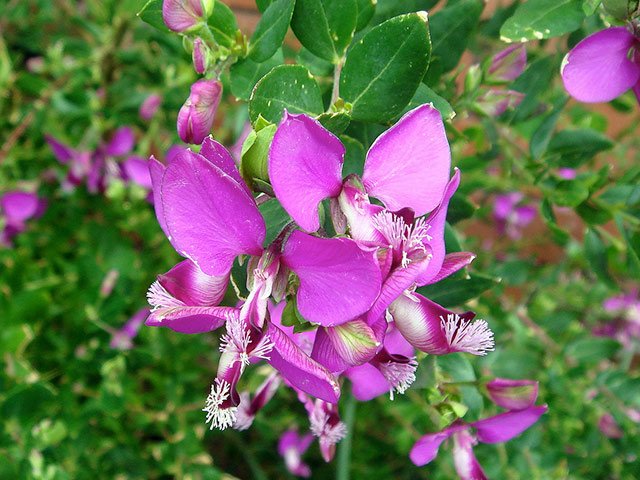
Hardy to 15-20 F. Polygala fruticosa is a coastal species that can even be found within the splash zone. This would make this a good candidate for beachside plantings. It also makes a good cut flower and lasts well in arrangements though the stem length on this cultivar is a bit short. We were first made aware of this plant by Doug Zylstra of West Covina Wholesale who had purchased the plant from Alta Nursery as Polygala grandiflora – to commemorate its source and indicate its larger size, we have come to call this distinctive plant Polygala 'Alta Mariposa'.
The name Polygala is Latin from the Greek word 'polugalon' for "much milk" because of the belief that cows grazing on milkwort increased their milk production. This description is based on our research and observations made of this plant as it grows in our nursery, in the nursery garden and in other gardens that we have visited. We will also incorporate comments received from others and always appreciate getting feedback of any kind from those who have some additional information about this plant, in particular if this information is contrary to what we have written or if they have additional cultural tips that would aid others in growing Polygala 'Alta Mariposa'.
https://www.smgrowers.com/products/plants/plantdisplay.asp?plant_id=3707
Polygala myrtifolia var. grandiflora is an evergreen shrub or small tree native to South Africa, bearing clusters of beautiful purple flowers that resemble those of sweet peas. This variety has larger, more richly coloured flowers and more tapered, pointed leaves in comparison to the species. In habit, it’s a rounded, bushy shrub that can eventually become a small tree.
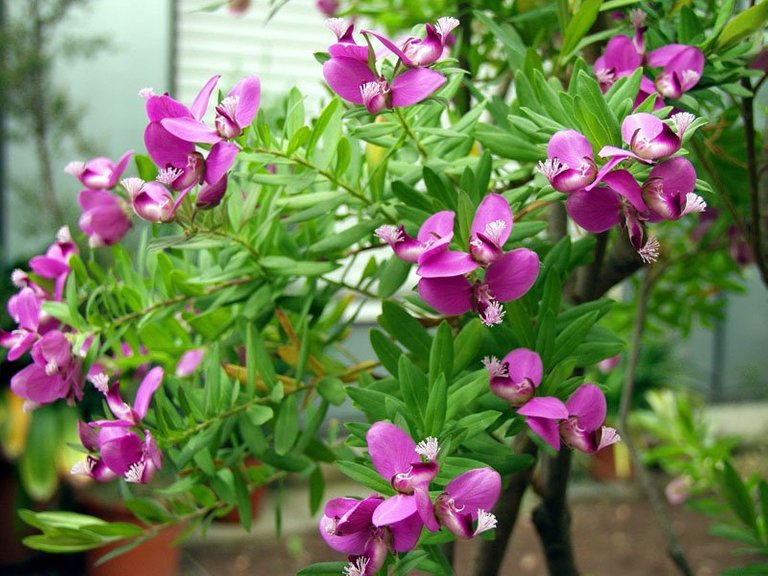

image source
It’s tender, so requires winter protection. Try growing it in a large pot or container that can be moved outdoors in summer, then indoors to a bright conservatory or greenhouse in winter.
image source
For best results, grow Polygala myrtifolia var. grandiflora in a large container in full sun, in moist, well-drained, humus-rich soil.
content source
Polygala of the milkwort family is a genus featuring over 500 species of plants (annuals, herbaceous perennials, subshrubs and shrubs) which are widely distributed in warm to temperate regions throughout the world. Plants are generally noted for having alternate lanceolate leaves and pea-like often showy flowers in terminal clusters/racemes.


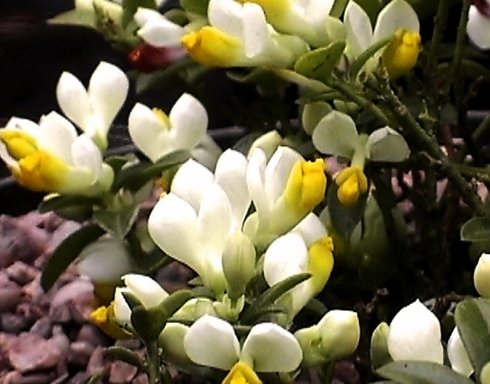
Polygala x dalmaisiana, commonly called sweet pea bush or milkwort, is a loose, leggy, fast-growing, rounded to spreading, bushy evergreen shrub which typically grows to 3-5’ tall and as wide. It is reportedly a hybrid between two South African species (P. opposistifolia and P. myrtifolia). Stems are clad with ovate dull green leaves (1” long). Terminal racemes of rose-magenta pea-like flowers with two winged petals surrounding a white purple crest bloom summer to frost, but bloom extends to almost year round in mild frost-free climates with minimum temperatures of 40 degrees F. Flowers resemble those of sweet pea.
Genus name comes from the Greek words polys meaning much and gala meaning milk in reference to a belief dating back to the medieval era that ingestion of plant leaves by certain nursing mammals resulted in increased milk production.
Hybrid name honors a French gardener by the name of Dalmais who reportedly raised this plant from seed in 1839.
http://www.missouribotanicalgarden.org/PlantFinder/PlantFinderDetails.aspx?taxonid=362665&isprofile=0&
Plant: Perennial shrub that can reach up to 3 meters in height.
Location: It is a very resistant plant and although we can enjoy it indoors in a bright space, it will grow better in full sun.
Flowering: From spring to mid-summer.
Soil: It prefers a fertile and light substrate to avoid waterlogging. It is a very rustic plant, so a special substrate for outdoor plants may be a good choice.
Temperature: Avoid minimum temperatures below 7ºC
Irrigation: Frequent in summer and more moderate the rest of the year.
Fertilizer: Special fertilizer for flower plants especially during the period of maximum growth between spring and late summer.
source